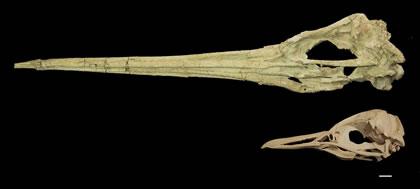Fossils show that giant, 1.5-metre-tall penguins lived on the beaches of Peru some 35 million years ago, when the equatorial region was relatively warm.
 The new find (top) compared to the only penguin living in Peru today (bottom).Courtesy of Daniel Ksepka
The new find (top) compared to the only penguin living in Peru today (bottom).Courtesy of Daniel KsepkaWeighing in at more than 60 kilograms, and brandishing a pointy, 20-centimetre beak, the prehistoric penguin Icadyptes salasi would have overshadowed the mighty emperor penguins that patrol Antarctica today. Let's just say it was not the sort of penguin you would want to run into in a dark alley.
The find, together with the discovery of a 40-million-year-old fossil of the slightly more diminutive giant penguin, Perudyptes devriesi, puts penguins in the tropics at least thirty million years earlier than expected, says Julia Clarke, a palaeontologist from North Carolina State University in Raleigh and lead author of the study. The fossils, found in exposed sandstone on the southern coast of Peru, are described in the Proceedings of the National Academy of Sciences of the USA.1
Modern penguins are thought to have adapted to cold climates, and previous evidence suggested that they didn't invade the tropics until 4-8 million years ago, long after a period of abrupt cooling dialled down the global thermostat about 34 million years ago. The new fossils, however, suggest that the penguins probably made the journey during earlier, balmier times, and that prehistoric giant penguins might have been more tolerant of warmer temperatures than their modern counterparts.
"Finding these fossils in Peru was a real surprise," says Ewan Fordyce, a palaeontologist at the University of Otago in Dunedin, New Zealand. "This shows significant diversification of penguins before the onset of icehouse Earth."
Previous to this, a South American penguin fossil from this time period has only been found at the continent's colder, southernmost tip.
Fish food
Although I. salasi cuts an imposing figure, it is only the third largest of the ancient giant penguins. Anthropornis nordenskjoeldi remains the reigning heavyweight, clocking in at nearly two metres tall and 100 kilograms — as tall and as heavy as a large man. A. nordenskjoeldi lived 45-37 million years ago on the coasts of Antarctica and New Zealand.
The new fossils provide a few clues as to how the tropical penguins might have lived. P. devriesi 's arm was shaped more like that of a flying bird's than are modern penguins', with mobile 'elbow' joints rather than rigid, paddle-like flippers. As a result, its underwater 'flight' might have been a bit awkward, says Clarke.
I. salasi 's sharp beak — longer and pointier than those of modern penguins — was better suited to quickly snapping up fish than feasting on tiny krill. Many ancient giant penguins, including I. salasi, have an enlarged region in the back of the head that might have supported bigger jaw-snapping muscles.
The penguins' size hints that the sea must have been swimming with fish back then, says Steven Emslie, an ornithologist at the University of North Carolina, Wilmington. "Larger body sizes evolve with consistent food sources," he says.
ADVERTISEMENT
Some researchers say that the Southern ocean opened up and isolated Antarctica about 41 million years ago. Alterations in ocean circulation around that time, including increased upwelling of nutrients from the ocean floor to the surface, may have benefited ocean productivity, says Fordyce.
Hot times
Just because these prehistoric birds flourished in warmer climes doesn't mean that modern penguins will escape global warming unscathed. Studies have shown that modern birds are sensitive to even small changes in temperature, and even modern tropical penguins of the Galapagos tend to cruise cooler water currents around the island.
"Our results do not speak to how penguins will be affected by current global warming conditions," says Clarke. "Global warming appears to be on a significantly shorter time scale than anything that we're talking about in this paper."
Visit our penguinslivedinperu.html">newsblog to read and post comments about this story.
